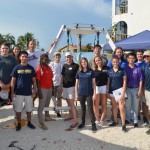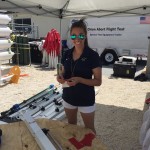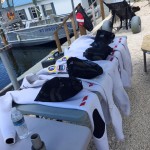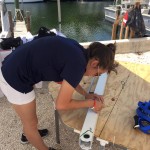Preparing astronauts for space is no easy task. With thousands of hours of training and little rest for the busy, NASA makes sure that astronauts are fully prepared in each and every way possible. One way NASA trains astronauts* is through the NASA Extreme Environment Mission Operations, or NEEMO. The NASA NEEMO missions are based in Key Largo, FL. 6.2 miles (5.4 nautical miles) out and 62 feet (19 meters) deep stands Aquarius. The world’s ONLY underwater laboratory in existence.
Astronauts will call Aquarius their home anywhere from one to two weeks. Once inside, the astronauts – now referred to as aquanauts – will conduct science experiments, research, testing, and even some extravehicular activities, or EVAs. The closest simulation to actual microgravity is being underwater. Conducting EVAs underwater allows rookie astronauts to somewhat experience the feeling of weightlessness without actually being weightless. That’s why the Neutral Buoyancy Lab, or NBL, comes in handy. EVAs conducted during the NASA NEEMO missions test out new equipment, team work, and even EVAs that might be conducted on Mars.
The commander of the NEEMO 20 mission is ESA astronaut Luca Parmitano. Parmitano is a veteran spaceflyer spending a total of 166 days living and working on board the International Space Station (ISS) during Expedition 36 and 37. Parmitano is no rookie when it comes to EVAs. He conducted two during his visit to the space station. Parmitano will be joined by NASA astronaut Serena Aunon, NASA EVA Management Office engineer David Coan, and JAXA astronaut Norishige “Nemo” Kanai.
This mission in particular will focus on “evaluating tools and techniques being tested for future spacewalks on a variety of surfaces and gravity levels ranging from asteroids to the moons of Mars and the Martian surface.” 1The mission will also “test time delays in communications due to the distance of potential mission destinations. The crew also will assess hardware sponsored by the European Space Agency (ESA) that allows crew members to read the next step in a procedure without taking their hands or eyes away from the task using a tablet, a smartphone and a head-mounted interface.” 2
Going into an extreme environment is no easy task and safety is key. Precautions are always taken and certified divers are always around just in case of an emergency, but the astronauts are well trained. Training for a NASA NEEMO mission starts about a month in advance, but the actual heavy duty training begins one week before splashdown. As I mentioned before, mission length varies but for the NEEMO 20 mission, it will last 2 weeks.
I was lucky enough to take part in the NASA NEEMO 20 mission. Embry-Riddle students and faculty were invited to be a part of the Mission Support Team. (Clearly an offer I could NOT turn down) I went down to Key Largo, FL Monday July 13th, 2015 through Wednesday July 15th, 2015. On Tuesday July 14th, 2015 I spent the whole day at the FIU Aquarius Reef Base. I met the NEEMO 20 crew along with the mission director Marc Reagan, and members of the mission support team: Barbara Janoiko, Jason Poffenberger, NEEMO 19 aquanaut Herve Stevenin, and a lot more! I also got the chance to meet the developer of NEEMO and NEEMO 1 aquanaut, Bill Todd, once again. I helped with the training of the astronauts as well as being an extra hand on base.
- My signature on a part of the CORAL II Tower. Image Credit: NASA
- Group Photo of the NASA NEEMO 20 Support Crew including NEEMO 20 astronauts & ERAU students/faculty.
- Putting the finishing touches on parts of the CORAL II Tower. Image Credit: Jason Kring
- The NEEMO 20 Crew suits. Image Credit: Skye Schwartz
- Putting the letters on the CORAL II Tower Image Credit: Jason Kring
The NASA NEEMO missions are another way that NASA prepares astronauts and mission support teams for future space exploration missions. The outreach of the astronauts and everyone involved is absolutely incredible.
To Luca Parmitano: enjoy your vampire slaying tool 😉
Special thanks to…
- Nye & Robert Schwartz for their continued love and support.
- Jason Kring & Bill Todd for the opportunity to take part in the NASA NEEMO 20 mission.
- Kati Anglin for guiding me through the process and teaching me new things.
- The NEEMO 20 crew for taking the time to talk to everyone including myself
- The NEEMO 20 crew for answering all my questions, especially Luca.
- The NEEMO 20 mission support team.
*Not every astronaut participates in these missions and some astronauts who do are already space veterans.
For more information on the NASA NEEMO program, visit:







